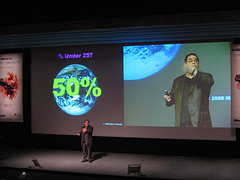From one literacy, to many, to one
There is no question that for students in the K-12 system in North America the ‘new’ literacies afforded by digital technologies play an integral role in their lives. The question is what role they should play in schools. Most of these students have never known a time without the Internet and have not had to do research when Google (circa 1998) and Wikipedia (2001) were not options. The question of whether these new tools for finding information and the skills required to use them1 are literacy is moot for these students. It is a question posed by those attempting to make sense of a rapid change in the learning styles and methods of their students—and in that sense it is necessary and useful. However, any consideration of new literacies as ‘lesser’ literacies entirely misses the point. The new literacies of what Bolter (2001) repeatedly terms “the late age of print” are additive in nature. That is, though there is much debate about the relative merits of various forms of representation, the effect is evolutionary and cumulative rather than revolutionary and exclusionary. Many literacies co-exist, supplement one another, extend into one another, and borrow and trade metaphors. As Dobson and Willinsky (2009) note, “…the paradox [is] that while digital literacy constitutes an entirely new medium for reading and writing, it is but a further extension of what writing first made of language” (p. 1). Certainly, for K-12 students, ‘new’ literacies are not new, they are simply literacy. Thus, multiliteracy, new literacy, digital literacy and information literacy, while useful concepts in the effort to problematize and deconstruct the changes, are all facets of one, evolving and growing literacy. Writing in 1996, the year many students currently in the eighth grade were born, the New London Group argued that “…literacy pedagogy now must account for the burgeoning variety of text forms associated with information and multimedia technologies” (p. 2). Whether accounted for or not, those forms and technologies are taken for granted by most students. It seems likely that ignoring this results in a type of cognitive dissonance for students which may make it more difficult for them to learn in classrooms in which print literacy is still the dominant, if not the only, mode. A danger, however, as Dobson and Willinsky (2009) note, is the tendency to assume that “…adolescents’ competence with new technologies—is often inappropriately reconstrued as incompetence with print-based literacies” (p. 11). Some technology enthusiasts, notable among them Marc Prensky, call for a wholesale shift from print to digital literacy.
Prensky has gone so far as to claim that “…it is very likely that our students’ brains have physically changed—and are different from ours—as a result of how they grew up” (Prensky, 2001, p. 1) and their immersion in digital technologies. While there has been some interesting research in recent years on brain plasticity, particularly with reference to interactions with technology, Prensky is justly criticized for going beyond the scientific evidence (McKenzie, 2007). Yet he does highlight important characteristics of the way students now learn and socialize2 using technology. Similarly, Prensky’s classification of parents and teachers as Digital Immigrants, and their children and students as Digital Natives, though overly simplistic is not entirely unhelpful in conceptualizing the current situation in classrooms. As with other immigrants, some adults have a more difficult time adapting to a new culture than do their children who have been raised in that culture. Of course, the situation is not as black and white as Prensky would have us believe. It is also sometimes true that adults who have made the choice to emigrate, and have done the research and made the sacrifices necessary to act on that choice, are more knowledgeable and participate to a higher degree than do their children who take the advantages and freedoms of the new country for granted. It is normal to find students today who have high
speed Internet access at home, access to a family desktop computer or a desktop, laptop or netbook computer of their own, a cellular telephone (capable of texting and taking photos and short movies), and an iPod or other MP3 player. In fact, the preceding is almost a list of standard equipment for a teenager in early 21st Century North America. And while it is still true that many schools do not encourage the use of most of these technologies in the classroom, an interesting phenomenon can be observed when teachers make an attempt to do so. The teacher, likely a Digital Immigrant in Prensky’s terms, has made some study of the technology to determine the ways in which it can be most usefully employed in pursuit of particular curricular objectives. What often becomes clear is that many of the Digital Native students, who appear quite facile with technology to the casual observer, are both a.) using only limited aspects of technology primarily for social purposes (MSN, Facebook, Twitter, etc.); and, b.) not fully comprehending the implications of the uses they do make of the technology. This is particularly evident with regard to services such as Facebook where it is not uncommon to find that students rely on default privacy settings, do not read the contract they agree to when opening an account which states that all material posted to the site becomes the property of Facebook, and do not consider the potential long-term consequences of statements or images they post. In short, students are not only taking the technologies and literacies for granted, they have little or no explicit understanding of them. What this argues for is again something that was anticipated by the New London Group thirteen years ago: the need for teachers and students to come together in a learning community to which both parties bring their knowledge, experience, learning styles and literacies.
To be relevant, learning processes need to recruit, rather than attempt to ignore and erase, the different subjectivities, interests, intentions, commitments, and purposes that students bring to learning. Curriculum now needs to mesh with different subjectivities, and with their attendant languages, discourses and registers, and use these as a resource for learning. (New London Group, 1996, p. 11)
Dobson and Willinsky (2009) hit exactly the right “Whiggish” note in the closing remarks to their draft chapter on digital literacy: “We must attend to where exactly and by what means digital literacy can be said to be furthering, or impeding, educational and democratic, as well as creative and literary, ends” (Dobson and Willinsky, 2009, p. 22). It is clear that the result of this attention must be an expansion of the definition of literacy to include many aspects made possible by its digital evolution.
Notes
up1 Dobson and Willinsky (2009) point out that literacy in the digital age includes the skills, often defined as information literacy, “… not just for decoding text, but for locating texts and establishing the relationship among them” (p. 19).
up2 “Social software constitutes a fairly substantial answer to the question of how digital literacy differs from and extends the work of print literacy” (Dobson and Willinsky, 2009, p. 21).
References
Bolter, J.D. (2001). Writing Space: Computers, Hypertext, and the Remediation of Print. Mahwah, NJ: Lawrence Erlbaum.
Dobson, T. and Willinsky, J. (2009). Digital Literacy. From draft version of a chapter for The Cambridge Handbook on Literacy.
McKenzie, J. (2007). Digital Nativism, Digital Delusions, and Digital Deprivation. From Now On, 17(2). Available: http://fno.org/nov07/nativism.html
Prensky, M. (2001). Digital Natives, Digital Immigrants. On the Horizon. NCB University Press, 9(5).




1 comment
1 Clare Roche { 11.30.09 at 7:23 pm }
I am curious about who will be responsible for designing these new materials.
You must log in to post a comment.